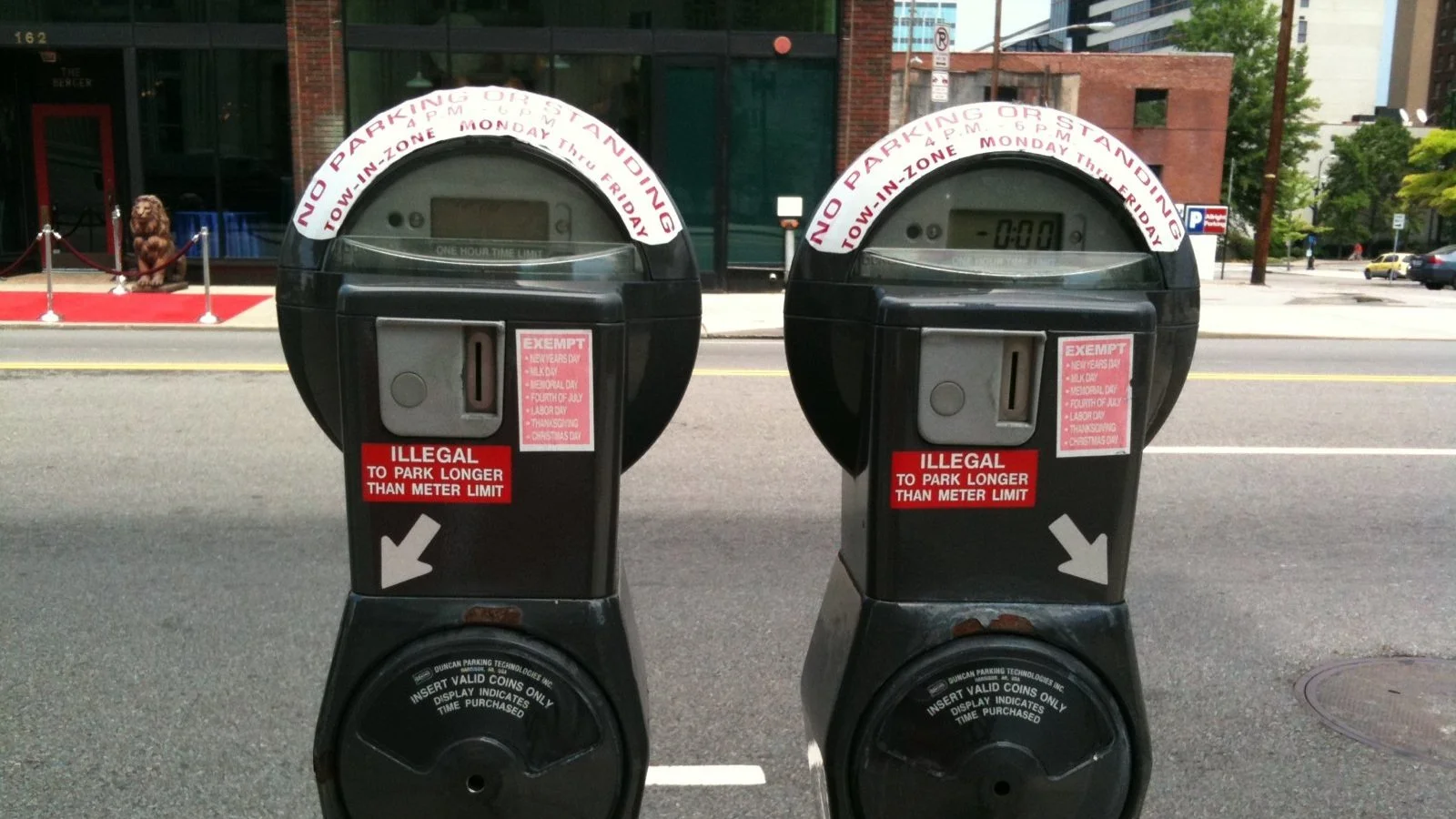Nashville an Unlikely Leader in Parking Reform
(Source: Flickr/Charles Wiriawan.)
Nashville, Tennessee, made the news recently for not only abolishing parking minimums within its urban core, but also establishing parking maximums in the same area. Many native Nashvillians and those who knew the city before its dramatic rise to “it” city status are still stunned at the ease with which the change was passed. But for many reasons, maybe we shouldn’t be.
Nashville’s an old city, as far as American towns go. It was founded by European settlers in 1779, before Tennessee was even a state. Its core reflects this: river-oriented, with narrower streets than you see in the later towns of the nineteenth century, like Memphis. But you’d be forgiven for not recognizing Nashville’s age. The city remained a sleepy Southern town until right around the time the Suburban Experiment began in earnest.
Nashville’s explosive horizontal growth across unincorporated Davidson County in the 1950s and beyond inspired the city founders to propose—and the populace to accept, the second time around—a radical solution to the problem of urban depopulation: consolidated city-county government. Metropolitan Nashville and Davidson County were born in 1963, and a single entity assumed all the functions of local government for a vast, 525-square mile expanse (with a few exceptions: five towns opted out). Nashville physically transformed into a city-county hybrid, quickly filling up with ranch suburbs, served by a spoke-and-wheel system of auto-oriented “pike” arterials. Those building this new Nashville wholeheartedly embraced car dependence, and every corner of the city was “updated” to reflect this obsession (even much of the historic downtown, which became pockmarked with parking lots).
Nashville’s latest transformation has caused a reckoning with the design decisions our grandparents made over half a century ago. From a trickle in the 90s to a flood in the 2010s, the country at large has rediscovered Nashville, leading to unprecedented levels of growth and development pressure—only this time, much of it being centered on the core, itself. These new residents (and many of the older ones, too) looked around at the neglected infrastructure of historic Nashville and asked reasonable questions, such as, “Why are there no sidewalks? Where did all the streetcars go?” Who needs those things, though, when you’ve got cars?
Of course, many Nashvillians, especially those who didn’t have cars, had always needed those things, but it was easy to ignore that fact in the early decades of the Suburban Experiment. Regardless, we finally set about building sidewalks once again, and adding bus service routes and increasing frequencies.
At the heart of it all, though, was an intractable tension: We wanted to have it both ways. We wanted to do these next right things and make our city more walkable, resilient, and equitable, but we also wanted to drive everywhere and not have to think about parking. Witness Nissan Stadium, on the East Bank of the Cumberland River opposite downtown: a downtown stadium, within walking distance of Nashville’s central business and entertainment district…surrounded by a sea of parking.
But that stadium is over 20 years old, and Nashville has done quite a bit of soul-searching since then. We’ve seen that all this desperately needed, infrastructure-maximizing infill does not run well on a transportation system designed almost entirely for the car. Turns out cars are fairly large and bulky, and there’s only so many you can fit on a road before absolute gridlock sets in (around 2 p.m., on a normal day). Obviously, bolder thinking was required.
Nashville had already taken several of these bold steps. Our downtown code, in effect since 2010, had no minimum parking requirements. And two years ago, Metro Council approved a zoning amendment that removed minimum parking requirements along all multimodal corridors within the Urban Zoning Overlay (UZO), or the area corresponding roughly to the historic “city of Nashville” before city-county consolidation in 1963.
But minimum parking regulations were silently killing many small projects across the large swath of the city where they still applied, and a lack of maximums was allowing parking to proliferate out of proportion to community desires, even downtown. Our general plan (NashvilleNext) and the Mayor’s Climate Action Plan had both cited parking minimums and vehicle miles traveled (VMT) as pernicious sources of housing inaffordability and greenhouse gasses. The steps we’d taken so far didn’t go far enough.
Enter Councilmember Colby Sledge: he’s Nashville's Metro councilmember for District 17, which encompasses many of the rapidly developing neighborhoods of South Nashville. He states his inspiration clearly: "Every underutilized parking garage in the urban core is a lost opportunity for housing. Past attempts to negotiate shared parking agreements involving hypothetical developments were time consuming and often fruitless. It became pretty clear that, if we were going to get serious about building housing, we needed to shift the conversation entirely."
Lisa Milligan, AICP, the land development manager at Metro, grasped the necessary shift. She first floated the idea of flipping the former parking minimums into parking maximums. She explains: “Removing minimums without actually addressing the number of spaces provided doesn’t get at the root of the problem—we shouldn’t be utilizing so much of our valuable land for storage of cars.”
As the leader of the team that reviews many of the biggest projects around the city, Milligan was acutely aware of how much land was being devoted to car storage, in a place where land is now at an absolute premium. Why not be proactive about managing this?
Many were skeptical at first. I mean, you need a car to get around in Nashville, don’t you? Do all of the new investments in our transit system fix this problem?
Councilmember Sledge addressed these concerns multiple times during the hearings of the past couple months: our ridership levels on major corridors are back up to pre-pandemic levels, frequencies along major bus routes are so frequent now that you don’t even need to consult a schedule, and WeGo (the name of our public transit authority), has received more funding and is working on expanding both traditional fixed route service and innovative new solutions like WeGo Link, which subsidize rideshare service to and from bus pickup locations (usually in more suburban areas).
And more and more people have decided they don’t need a car in Nashville, or that they only need one per household. The public hearings were replete with residents in support who recognized that their personal decisions to reduce vehicle miles traveled, ride transit, and downsize the number of vehicles they owned were being hampered by the city’s official policy of forcing parking on most of its property owners. Speaker after speaker made the connection between out of control housing costs, environmental degradation, and congestion on the one hand, and mandatory and unlimited parking on the other.
"Parking minimums have an especially devastating effect on affordable housing. During public hearing on the bill, one of our largest non-profit affordable housing builders testified that, for every two parking spaces she's had to build because of parking minimums, she could have built an additional unit of affordable housing. The choice was clear," Councilmember Sledge said.
There was opposition—but even those who spoke against the bill acknowledged that it was a step in the right direction. The chief criticism was that it was too much of a step, too soon. Either they took issue with setting maximums, or they raised concerns about parking spillover into those residential neighborhoods that back up to commercial areas. Many, seemingly unaware of the increased frequency and convenience of WeGo’s services, argued that more robust transit provision should come first, and that this was getting the cart before the horse.
But Councilmembers Sledge and Angie Henderson remained steadfast: the time is now. "Parking minimums strangle the creativity and flexibility that make neighborhoods and cities such great places to live,” Councilmember Sledge emphasized.
The council had already taken action before to beef up the residential parking permit program and support enforcement. Even more funding is in the pipeline for WeGo. And of course, the effects of the bill, if passed now, would take years to be felt (the development process being such as it is). Parking Armageddon was in no way imminent. Councilmember Sledge summarizes the coming effects succinctly: “Instead of focusing on squeezing in mandated parking spaces, small business owners now can focus on creating places that people want to visit and enjoy."
So, it’s not a drastic shakeup. At a deeper level, though, the bill does represent a fundamental shift in our priorities, but it’s one we’ve all agreed to, as a city, many times over by this point: Nearly every community across Metropolitan Nashville has identified sprawl as enemy number one, with no end to the public planning documents and statements and declarations calling for a new approach. But it wasn’t until now that the perfect storm of bold leadership and broad public support finally coalesced into a practical action plan for striking at the heart of the tottering Suburban Experiment. Its greatest strength (but also its Achilles’ heel) is plentiful, free parking. And for those staring this monster in the face, it’s the definitive jumping off point: as Chuck Marohn stated in a recent Upzoned podcast on the subject, it’s the bare minimum, the sine qua non, the price of admission to the club of Strong Towns. Nashville slashed its minimums and pressed its advantage, imposing maximums on the beast and bridling it once and for all within the city’s historic urban boundaries. The results will take years to see, but the energy is already palpable.
Here in Nashville, we’re still quite enmeshed in the results of the Suburban Experiment. Many of our neighborhoods have few, if any, pedestrian amenities, and there are several corners of the county untouched by public transit. Attitudes about infill and mixed use are mixed, with many uneasy about the types of design and development interventions that could render our places stronger and more livable. Despite all that—or maybe because of it—we have found the courage to do the next right thing regarding the elephant (or the multi-level parking garage) in the room.
Strong Towns member Dustin Shane, AICP, is an urban planner interested in exploring the intersection of philosophy, culture, and city building. He blogs about these and other topics at placeandtheory.com. He and his wife Maude are natives of Nashville and Middle Tennessee and enjoy fishing, local history, house spotting, and cooking.


